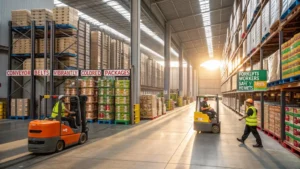What Is Supply Chain Globalization?
You’ve likely purchased products today that traveled thousands of miles before reaching your hands, yet you probably didn’t think twice about their journey. This seamless flow of goods across continents represents supply chain globalization—a complex web of international partnerships, manufacturing processes, and logistics networks that’s quietly revolutionized how businesses operate. But understanding what drives this transformation and why it matters to your daily life reveals surprising truths about our interconnected world.

Defining Supply Chain Globalization
You’ll find that several powerful forces have shaped how supply chains have evolved from local operations to today’s interconnected global networks. Cost reduction remains the primary catalyst, as companies seek cheaper labor, raw materials, and manufacturing locations across different countries. Technology advances, trade liberalization, and consumer demand for diverse products have accelerated this transformation, making it easier and more profitable for businesses to coordinate complex operations worldwide. Innovations like containerization and internet connectivity have been fundamental in facilitating these global operations by standardizing shipping processes and enabling real-time communication across borders.
Key Drivers of Globalization in Supply Chains
When you examine how supply chains have evolved into globally interconnected networks, you’ll find that five key drivers have fundamentally reshaped how businesses source, produce, and distribute goods worldwide.
Market dynamics drive convergence as consumer behavior becomes increasingly standardized across regions, creating demand for uniform products and global sourcing strategies. Cost efficiencies emerge through scale economies and international sourcing advantages that reduce unit costs markedly. Competitive strategies intensify as companies face rivals from multiple continents, forcing broader market participation. Companies establish overseas factories to benefit from tariff concessions, lower labor costs, and reduced logistics expenses while gaining improved access to foreign markets. Government policies facilitate expansion through favorable trade agreements and regulatory harmonization that reduce cross-border barriers. Finally, technological advancements enable sophisticated coordination through automation, digitization, and logistics optimization systems that connect suppliers and consumers seamlessly across global networks.
How Globalized Supply Chains Work
To truly understand how globalized supply chains function, you’ll benefit from examining a concrete example that demonstrates these complex networks in action. Apple’s supply chain illustrates how a single company coordinates sourcing, manufacturing, and distribution across dozens of countries to deliver products worldwide. You’ll see how this tech giant leverages global partnerships, manages regulatory complexities, and orchestrates logistics to maintain its competitive advantage. These networks facilitate international trade by connecting buyers with suppliers across multiple continents and countries.
Real-World Example: Apple’s Global Supply Chain
Apple’s global supply chain represents one of the most sophisticated examples of how modern companies orchestrate production across continents. You’ll find Apple partnerships spanning Taiwan, China, India, Japan, and Vietnam, with key suppliers like Foxconn, Pegatron, and Samsung. Their global sourcing strategy diversifies components across multiple regions to guarantee supply continuity.
Manufacturing diversification reduces overreliance on single locations, with facilities expanding beyond China into India and Vietnam. Quality assurance remains paramount through rigorous supplier audits and multi-layered production checks. Risk mitigation involves strategic supplier relationships and geographic distribution to counter geopolitical uncertainties.
Environmental sustainability drives clean energy investments and responsible sourcing practices. Apple has committed to achieving a carbon-neutral supply chain by 2030, building on its carbon-neutral corporate operations since 2020. Logistics optimization utilizes real-time analytics, ERP systems, and automated coordination to synchronize supply and demand across time zones, demonstrating how globalized supply chains maximize efficiency while managing complexity.
Benefits of Supply Chain Globalization
Although supply chain globalization presents certain challenges, it has delivered substantial benefits that have transformed how businesses operate and consumers shop. You’ll find that cost efficiency improves dramatically when companies shift production to lower-cost regions and achieve economies of scale through global networks. Market accessibility expands exponentially, allowing you to reach new customer bases while offering diverse product ranges tailored to regional preferences.
Innovation potential accelerates through international collaboration, enabling access to cutting-edge technologies and specialized expertise worldwide. The integrative technologies, particularly the internet, have facilitated this cross-border economic integration by connecting suppliers, manufacturers, and distributors across continents. Consumer diversity benefits from wider product variety, lower prices, and faster delivery times that enhance your shopping experience. Workforce development flourishes as new employment opportunities emerge globally. While environmental impact remains complex, globalization facilitates the rapid adoption of green technologies and sustainable practices across international supply networks.
Challenges and Risks of Globalized Supply Chains
You’ve seen how globalized supply chains can deliver cost savings and efficiency, but they’re also vulnerable to massive disruptions that can ripple across continents. The COVID-19 pandemic provided a stark real-world example of how interconnected networks can become fragile when faced with unprecedented global challenges. Today, businesses are grappling with geopolitical conflicts and other emerging threats that have made supply chain disruptions the new normal rather than exceptional events. Let’s examine how this crisis exposed the critical weaknesses in our globalized supply chain systems and what lessons we can learn from it.
Case Study: Impact of COVID-19 on Global Supply Chains
When the COVID-19 pandemic struck in early 2020, it exposed the fragility of globalized supply chains in ways that few business leaders had anticipated. You witnessed major production halts and material flow disruptions as lockdowns and staff shortages cascaded globally. The Global Supply Chain Pressure Index registered dramatic surges, with shipping delays and order backlogs reaching unprecedented levels.
Your pandemic response likely required immediate supply chain adaptations – 64% of retailers pivoted to e-commerce operations. You probably experienced firsthand how international linkages amplified economic shocks across borders. Supply chain resilience became paramount as bottlenecks persisted through 2021.
Moving forward, you’ll need diversified sourcing strategies and enhanced risk management. Investment in automation and technology acceleration is projected at 14% annually through 2025, reflecting lessons learned from this global disruption. Companies recognized that workforce disruptions became a critical vulnerability, with 47% experiencing significant challenges in maintaining adequate staffing levels across their global operations.
The Role of Technology in Managing Global Supply Chains
Since global supply chains span continents and involve countless moving parts, you’ll need sophisticated technology to manage their complexity effectively. AI optimization increases efficiency by 40% through advanced forecasting and automation, which streamlines operations. Robotics integration transforms warehouses with autonomous vehicles and drones, addressing labor shortages while improving accuracy.
Digital connectivity links global partners through cloud-based systems and IoT devices, enabling real-time tracking and rapid response to disruptions. Data transparency creates actionable insights from vast datasets, while predictive analytics anticipate demand shifts and supplier risks before they impact operations.
Effective inventory management relies on machine learning algorithms that optimize stock levels and procurement strategies. However, increased digitalization requires robust cybersecurity measures to protect sensitive data and maintain operational integrity across your global network. Supply chain leaders must implement near-real-time monitoring systems to proactively identify and address potential disruptions before they escalate into major operational challenges.
Supply Chain Globalization vs. Localization: A Future Perspective
Although technology has revolutionized how you manage global supply chains, it’s also sparked a fundamental debate about whether the future lies in expanding globalization or embracing localization. You’re increasingly seeing companies adopt hybrid strategies that combine global reach with local responsiveness, balancing efficiency against supply chain resilience. Nearshoring benefits include reduced transportation costs, shorter lead times, and improved quality control while maintaining some geographic diversification.
You’ll notice regulatory and consumer pressure for sustainability favoring localized approaches, especially in critical industries. However, you must weigh higher production costs and limited supplier pools against increased resilience to global disruptions. Companies like Google, Microsoft, and Amazon demonstrate how global enterprises can successfully implement both strategies to optimize their supply chain operations. The future likely demands regionalization strategies that provide both scalability and risk mitigation, allowing you to respond quickly to local market demands while maintaining competitive pricing.
Frequently Asked Questions
What Industries Were the First to Adopt Globalized Supply Chain Strategies?
You’ll find the automotive industry led early supply chain globalization with Ford’s assembly lines in the 1920s-30s. The technology sector followed post-WWII, establishing global production hubs and pioneering just-in-time manufacturing practices worldwide.
How Do Companies Measure the Success of Their Global Supply Chain Investments?
You’ll track performance metrics relentlessly, you’ll analyze investment returns constantly, and you’ll monitor efficiency obsessively. Companies measure global supply chain success through inventory turnover, ROI calculations, customer satisfaction scores, and cost-reduction percentages against revenue targets.
What Specific Regulations Govern Cross-Border Supply Chain Operations?
You’ll need to navigate WTO rules, trade agreements like USMCA, and customs compliance requirements. You’re also bound by supply chain due diligence laws, environmental standards, and forced labor prevention acts governing cross-border operations.
Which Countries Are Emerging as New Global Supply Chain Hubs?
Vietnam’s manufacturing exports jumped 8% in 2023, showcasing the impact of supply chain innovation. You’ll find emerging markets like Vietnam, Mexico, and India becoming dominant hubs as companies diversify from China, seeking cost advantages and geopolitical stability.
How Long Does It Typically Take to Establish a Global Supply Chain?
You’ll need 2-4 years for the complete supply chain duration when implementing a global strategy. Your timeline includes 6-18 months for planning and supplier integration, plus 1-3 years for infrastructure development and regulatory compliance across multiple countries.
How does globalization impact supply chain management?
Globalization expands supply chain management beyond national borders, introducing both opportunities and challenges. It allows companies to source materials from low-cost regions and sell to international markets, but it also requires managing complex networks, time zones, regulations, and cultural differences.
What are the benefits of global supply chain management?
Global supply chain management helps businesses reduce production costs, access a broader supplier base, scale operations quickly, and increase competitiveness in global markets. It also enhances innovation through global collaboration.
